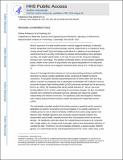Remote-Controlled Mice
Author(s)
Anikeeva, Polina Olegovna; Jia, Xiaoting
DownloadAnikeeva_Remote-controlled mice.pdf (80.84Kb)
PUBLISHER_CC
Publisher with Creative Commons License
Creative Commons Attribution
Terms of use
Metadata
Show full item recordAbstract
What if expression of a light-sensitive protein could be triggered wirelessly, on demand? What if optogenetics and neuropharmacology could be implemented in an untethered, freely moving animal model? Such technology would allow for a plethora of neurobiological experiments that are currently confounded by repeated animal handling, tissue-damaging cannulas, and tangled optical cables. In the July 30 issue of Cell, Jeong and colleagues introduce such a technology. The ultrathin and flexible devices, termed wireless optofluidic probes, enable remote control of drug infusion and optical manipulation in the deep-brain regions of freely moving mice engaged in behavioral tasks
Date issued
2015-08Department
Massachusetts Institute of Technology. Department of Materials Science and Engineering; Massachusetts Institute of Technology. Research Laboratory of ElectronicsJournal
Cell Systems
Publisher
Elsevier
Citation
Anikeeva, Polina, and Jia, Xiaoting. “Remote-Controlled Mice.” Cell Systems 1, 2 (August 2015): 104–105 © 2015 Elsevier
Version: Author's final manuscript
ISSN
2405-4712